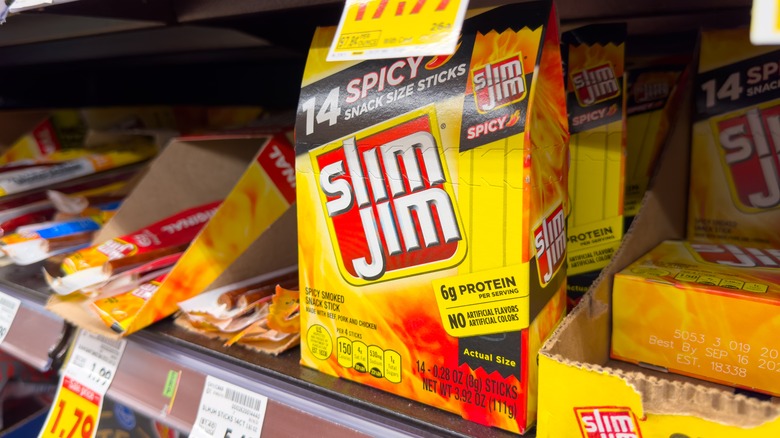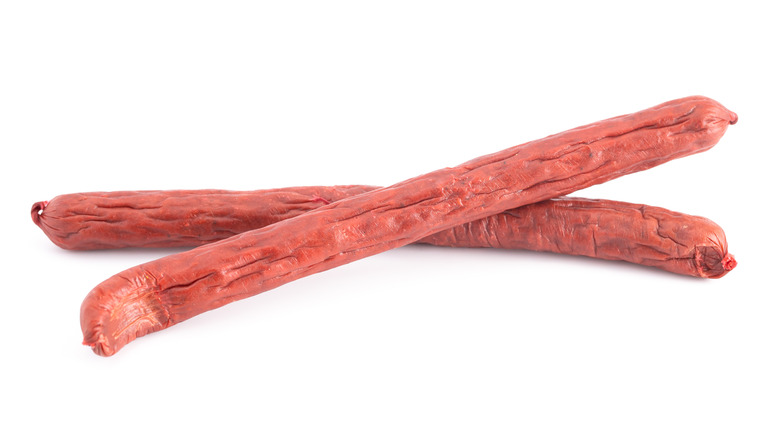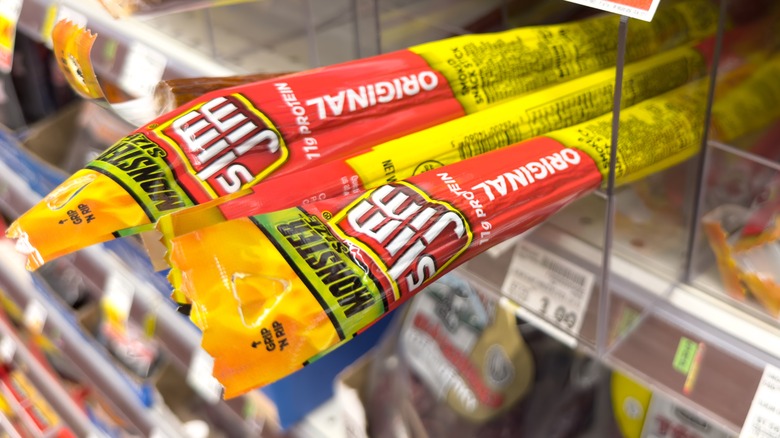What's In A Slim Jim, Really?
If you've ever stopped at any convenience store to pick up a quick snack, then you've probably purchased at least one Slim Jim in your life — or at least considered it. The Slim Jim is known as the ultimate handheld snack; it's made with meat, so it's meant to keep you full while you're on the move, whether it's a long car ride or a day on the job. But what's in it? The answer is a little more complicated than you'd think.
This popular snack was invented in the 1940s as a bar snack to pair with drinks. In 1967, the brand was sold to General Mills for around $20 million. While Slim Jims contain mostly beef — but not the type you'd use for the perfect steak — there's more happening on the production line that you should know about. Essentially, it's made with low-quality beef, pork, chicken (but not the white meat kind you're grilling at home), and other fillers like corn and wheat proteins. Slim Jims are produced in bulk at the ConAgra Foods plant in Troy, Ohio, which makes nearly one billion of these salty snacks each year.
So, what exactly is in a Slim Jim?
Slim Jims are considered processed meat, so they're made with lower-quality beef than what you'd bring home from the grocery store. Processed meats usually involve one of three meat types: Canner, utility, and cutter. All three fall in the lowest-grade category. Utility meat is usually used for frozen or canned meals, while some sources assert that cutter and canner meats are used in pet food. However, the exact type of processed beef Slim Jim uses is unknown. These cuts usually come from older cows with less desirable meat.
The beef is supplemented with a little pork, as well as something called mechanically separated chicken, which the USDA says is made "by forcing bones, with attached edible meat, under high pressure through a sieve or similar device to separate the bone from the edible meat tissue." The result is a paste-like substance that is sometimes used in hot dogs and nuggets — and Slim Jims.
Beyond that, the Slim Jim meat is supplemented with the addition of other types of proteins and amino acids. Wheat and corn proteins make their way in there, as well as soy proteins which are further broken down into amino acids. It all comes together to form that salty snack you might love, but not without the addition of preservatives.
Why do Slim Jims taste so salty?
Along with the beef and proteins, Slim Jims have a number of preservatives added in order to prevent the meat from going bad. "Good" bacteria are intentionally added to feed on lactic acid and prevent the meat's pH from rising (this helps avoid bad bacteria growth). Sodium nitrate is in there, too, to prevent toxins and keep the meat's signature deep red color. But the preservative you're likely the most aware of is exactly why you need a drink after eating a Slim Jim: It has plenty of salt.
Each snack stick contains around 130 milligrams of sodium, but there are four sticks in a serving, totaling to 530 milligrams – 23% of the recommended daily sodium value. In addition to the salt, each serving also contains 150 calories, 11 grams of fat, and 6 grams of protein. Despite the fact that Slim Jims might not contain the highest-quality ingredients, they draw consumers for three reasons: They're filling, they're salty (which equates to our taste buds thinking they're good), and they're inexpensive. A 46-pack of snack sticks costs around $18, which is far less than what you'd pay for the same amount of beef jerky.


